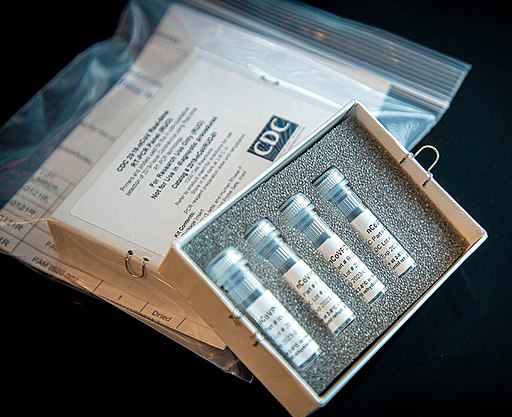
U.S. Centers for Disease Control / Public domain
Where did this week go? I meant to share with you earlier this resource document from the CDC on employee COVID-19 tests in non-healthcare workplaces. Well, better late than never.
The CDC describes strategies for SARS-CoV-2 viral testing for five categories of people:
- Testing individuals with signs or symptoms consistent with COVID-19
- Testing asymptomatic individuals with recent known or suspected exposure to SARS-CoV-2 to control transmission
- Testing asymptomatic individuals without known or suspected exposure to SARS-CoV-2 for early identification in special settings
- Testing to determine resolution of infection (e.g., discontinuation of home isolation)
- Public health surveillance for SARS-CoV-2
Testing individuals with signs or symptoms consistent with COVID-19
It should come as no surprise that you guys won’t be doing any of the actual COVID-19 testing for employees showing signs or symptoms of COVID-19. Instead, separate these employees, send them home, and refer them to a healthcare provider for evaluation and potential testing. These employees should not return to work until test results are in, at the earliest.
Testing asymptomatic individuals with recent known or suspected exposure to SARS-CoV-2 to control transmission
The CDC recommends COVID-19 viral for all close contacts of persons with COVID-19. Viral testing can detect if these individuals are currently infected. The health department may reach out to the employer for assistance in identifying close contacts of the worker as well as possible contacts. The CDC encourages employers to work with public health departments investigating cases of COVID-19 and tracing contacts to help reduce the spread of SARS-CoV-2 in their workplaces and communities. Also, the CDC wishes to remind you that to avoid loose lips with COVID-19 diagnoses. That’s consistent with the Americans with Disabilities Act (ADA) and EEOC guidance regarding What You Should Know About COVID-19 and the ADA, the Rehabilitation Act, and Other EEO Laws.
Testing asymptomatic individuals without known or suspected exposure to SARS-CoV-2 for early identification in special settings
Several considerations go into when and how often to test in this situation. One option is initial testing of all workers before entering a workplace. Others include periodic testing of workers at regular intervals, or targeted testing of new workers or those returning from a prolonged absence. The CDC lists several helpful factors in determining the interval for periodic testing:
- The availability of testing
- The latency between exposure and development of a positive SARS-CoV-2 viral test
- Businesses that fall into one of the workplace categories described above
- The rate or change in rate of people getting infected in the surrounding community
- How many employees tested positive during previous rounds of testing
- Your relevant experience with workplace outbreaks
Testing to determine resolution of infection (e.g., discontinuation of home isolation)
(I’m going full cut-and-paste on this).
Options include a symptom-based (i.e., time-since-illness-onset and time-since-recovery strategy), time based, or a test-based strategy. Viral tests have detected viral RNA in some people’s respiratory samples after they have recovered from COVID-19. Prolonged viral shedding has been demonstrated without direct correlation with replication competent virus. The determination of which strategy to use should be made in consultation with healthcare providers and public health professionals.
Public health surveillance for SARS-CoV-2
This sounds like some spy movie stuff right here. From the CDC:
Testing is considered to be surveillance when conducted to detect transmission hot spots, or to better understand disease trends in a workplace. These goals are consistent with employer-based occupational medicine surveillance programs. Occupational medicine surveillance programs may use testing to assess the burden of SARS-CoV-2 in the workforce, assess factors that place employees at risk for workplace acquisition of SARS-CoV-2, or evaluate the effectiveness of workplace infection control programs. Surveillance should only be undertaken if the results have a reasonable likelihood of benefiting workers.
But, I’ve got to be honest. I have no idea what this means.
If you want to try to decipher the code or review the entire CDC guidance, you can check it out for yourself here.
